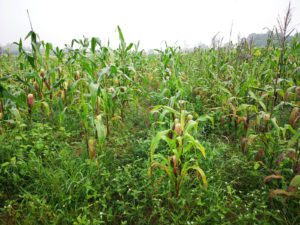Bacterial canker of tomato is caused by the bacterium Clavibacter michiganense pv. michiganense.
It is an infectious disease of fresh-market and processing tomatoes that usually results in reduced yields and premature fruit drop. The white blisters, which occur on infected tomatoes reduce the fresh-market value of the fruit.
Bacterial canker can spread rapidly through a crop and can cause near total losses.
Early recognition of the disease is essential if the disease is to be contained.
Disease Cycle
The bacterium that causes bacterial canker can be brought into the garden on infected seed or transplants, which may not show symptoms of disease.
Bacteria ooze from the cankers and spreads to other plants. It spreads on splashing water from rain or irrigation, or on hands and tools of workers.
The bacterium survives up to three years on plant debris and for several months on stakes and equipment.it can also infect and survive on nightshades, weeds that are closely related to tomato, and tomato plants that grow from the previous season’s fallen fruit.
Disease development is favoured by warm temperatures and high moisture or relative humidity.
Signs and Symptoms
Symptoms of bacterial canker occur on all above ground plant parts, but the first symptoms usually appear on older leaves. They vary with factors like age of plant, type of infection and environmental conditions, among others.
Seedlings– they develop small, white, raised spots on leaves and may completely wilt and die in severe cases of infection.
Leaves-when infected, yellow to tan patches form between veins, the edges of the leaf turn brown, with a yellow border and dark, sunken veins form on the leaves and petioles. The lower leaves wilt, oftenly on one side only and the entire plant may collapse and die eventually.
Stem– brown streaks can be seen in the vascular system when the stem is cut open. The stem splits forming long, brown cankers and yellow sticky fluid may emerge from cut stem when squeezed.
Fruit– small, creamy, white spots with tan or brown centers (‘bird’s eye’ spots) on fruit form and the fruit surface may appear netted or marbled.
Disease Management
Chemical control
For an effective control of the canker disease, copper-based fungicides are recommended. Copper is known to suppress and prevent the movement of bacteria in the soil.
These include;
- GREENCOP 500WP
- TRINITY GOLD 452 WP
- COLONIZER 440WP
Crops sprayed with BIODISTINCTION XTRA have a better protection against the bacterial infection.
Drenching PYRAMID 700WP to suppress activity of the bacteria within the plant
Non-chemical control methods
- Use disease-free or certified planting materials.
- Destroy old tomato plants immediately after final harvest.
- Do not allow volunteer plants to grow between seasons or amongst cover crops, because they can harbour the disease.
- Control solanaceous weeds such as nightshades in and around the crop.
- Do not rotate or grow tomato crops with crops in the same family like capsicum, potato or eggplant.
- Provide appropriate amounts of fertilizer and water because plants that are stressed or those that are growing too luxuriantly can be more susceptible to disease.
- Use drip rather than overhead irrigation. Water splashed during overhead irrigation spreads the pathogen. When overhead irrigation is the only option, water during the day with enough time to ensure that the plants are dry by nightfall.
- Monitor crops thoroughly for bacterial and other diseases regularly.
- Avoid working fields when plants are wet.
- Disinfect spray equipment/ machinery with a general disinfectant before and after using.
- Do not save seed from infected plants
- Use disease tolerant/resistant varieties.
Note;
- Fungicides should be mixed with INTEGRA 3ml/20l whenever spraying. This is a sticker, spreader and penetrant which improves the effectiveness of the fungicide.
- A proper nutrition increases the crop’s resistance to infections.
- Timely control of the disease is very critical.






